People
by
Christopher Baker
Home : Travel : Costa Rica : CR Handbook : One Article
POPULATION
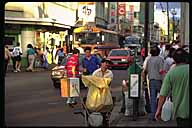 The July 1989 census recorded a population of 2.92 million, more than half of
whom live in the Central Valley. Approximately 275,000 live in the capital city
of San José. Fifty-one percent of the nation's population is classed as
urban. The country's annual population growth rate is currently 2.3% and
gradually falling. As recently as the 1960s the rate was a staggering 3.8% per
annum, a figure no other country in the world could then match. The impressive
decline in recent decades has likewise been matched by few other countries.
The July 1989 census recorded a population of 2.92 million, more than half of
whom live in the Central Valley. Approximately 275,000 live in the capital city
of San José. Fifty-one percent of the nation's population is classed as
urban. The country's annual population growth rate is currently 2.3% and
gradually falling. As recently as the 1960s the rate was a staggering 3.8% per
annum, a figure no other country in the world could then match. The impressive
decline in recent decades has likewise been matched by few other countries.
All the municipalities of the Meseta Central have gained
agricultural migrants for whom there is simply no more room. Hence, emigration
from the Meseta Central in recent decades has taken people in all directions,
assisted by government incentives. The most attractive areas of settlement in
the past 35 years have been on the Nicoya lowlands on the drier part of the
Pacific coast, on the northern lowlands, and on the alluvial soils of the Valle
de El General in the south. The Pan-American Highway has attracted settlers,
and the border between Panama and Costa Rica is now quite densely settled, with
colonists from Italy as well as the Meseta Central grafted onto the local
population.
CLASS AND RACE
Most Costa Ricans insist that their country is a "classless democracy."
True, the social tensions of class versus class that characterize many
neighboring nations are absent. Ticos lack the volatility, ultranationalism,
and deep-seated political divisions of their Latin American brethren. There is
considerable social mobility, and no race problem on the scale of the United
States'. And virtually everyone shares a so-called middle-class mentality, a
firm belief in the Costa Rican equivalent of "the American Dream"--a conviction
that through individual effort and sacrifice and a faith in schooling every
Costa Rican can climb the social ladder and better him- or herself.
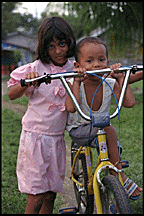 Still, despite the high value Ticos place on equality and
democracy, their society contains all kinds of inequities. Wealth is unevenly
distributed (the richest one percent of families receive 10% of the national
income; the poorest 50% receive only 20%; and at least one-fifth of the
population remain marginados who are so poor they remain outside the
mainstream of progress).
Still, despite the high value Ticos place on equality and
democracy, their society contains all kinds of inequities. Wealth is unevenly
distributed (the richest one percent of families receive 10% of the national
income; the poorest 50% receive only 20%; and at least one-fifth of the
population remain marginados who are so poor they remain outside the
mainstream of progress).
A small number of families--the descendants of the original
hidalgos (nobles)--have monopolized power for almost four centuries
(just three families have produced 36 of Costa Rica's 49 presidents, and fully
three-quarters of congressmen 1821-1970 were the offspring of this "dynasty of
conquistadores").
Urbanites, like city dwellers worldwide, condescendingly chuckle at
rural "hicks." The skewed tenure of an albeit much-diluted feudalism persists
in regions long dominated by plantations and haciendas. The upwardly mobile
consider menial labor demeaning. And tolerance of racial minorities is tenuous,
with "whiteness" still considered the ideal.
Though comparatively wealthy compared to most Latin American
countries, by developed-world standards most Costa Ricans are poor (the average
income is slightly less than US$3000 per annum). Many rural families still live
in simple huts of adobe or wood; the average income in the northern lowlands,
for example, is barely one-seventh that in San José. And although few
and far between, shacks made from gasoline tins, old automobile tires, and
corrugated tin give a miserable cover to poor urban laborers in small
tugurios--illegally erected slums--on the outskirts and the riverbanks
of San José.
However, that all paints far too gloomy a picture. In a region
where thousands thrive and millions starve, the vast majority of Costa Ricans
are comparatively well-to-do. The country has few desperately poor, and there
are very few beggars existing on the bare charity of the world. The majority of
Costa Ricans keep their proud little bungalows spick and span and bordered by
flowers, and even the poorest Costa Ricans are generally well groomed and
neatly, even formally, dressed: the men in fedoras, the women in shawls.
Overt class distinctions are kept within bounds by a delicate
balance between "elitism" and egalitarianism unique in the isthmus:
aristocratic airs are frowned on and blatant pride in blue blood is ridiculed;
even the president is inclined to mingle in public in casual clothing and is
commonly addressed in general conversation by his first name or nickname.
Costa Rican Ethnicity
Costa Rica is unquestionably the most homogeneous of Central American nations
in race as well as social class. Travelers familiar with other Central American
nations will immediately notice the contrast: the vast majority of Costa Ricans
look predominantly European. The 1989 census classified 98% of the population
as "white" or "mestizo," and less than two percent as "black" or "Indian."
Native and European mixed blood far less than in other New World countries.
There are mestizos--in fact, approximately 95% of Ticans inherit varying
mixtures of the mestizo blend of European colonists with Indian and black
women--but the lighter complexion of Old World immigrants is evident throughout
the nation. Exceptions are Guanacaste, where almost half the population is
visibly mestizo, a legacy of the more pervasive unions between Spanish
colonists and Chorotega Indians through several generations. And the population
of the Atlantic coast province of Puerto Limón is one-third black, with
a distinct culture that reflects its West Indian origins.
Blacks
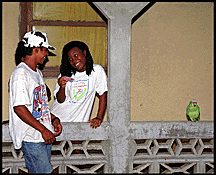 Costa Rica's approximately 40,000 black people are the nation's largest
minority. For many years they were the target of racist immigration and
residence laws that restricted them to the Caribbean coast (only as late as
1949, when the new Constitution abrogated apartheid on the Atlantic Railroad,
were blacks allowed to travel beyond Siquerres and enter the highlands). Hence,
they remained isolated from national culture. Although Afro-Caribbean turtle
hunters settled on the Caribbean coast as early as 1825, most blacks today
trace their ancestry back to the 10,000 or so Jamaicans hired by Minor Keith to
build the Atlantic Railroad, and to later waves of immigrants who came to work
the banana plantations in the late 19th century.
Costa Rica's approximately 40,000 black people are the nation's largest
minority. For many years they were the target of racist immigration and
residence laws that restricted them to the Caribbean coast (only as late as
1949, when the new Constitution abrogated apartheid on the Atlantic Railroad,
were blacks allowed to travel beyond Siquerres and enter the highlands). Hence,
they remained isolated from national culture. Although Afro-Caribbean turtle
hunters settled on the Caribbean coast as early as 1825, most blacks today
trace their ancestry back to the 10,000 or so Jamaicans hired by Minor Keith to
build the Atlantic Railroad, and to later waves of immigrants who came to work
the banana plantations in the late 19th century.
Costa Rica's early black population was "dramatically upwardly
mobile" and by the 1920s a majority of the West Indian immigrants owned plots
of land or had risen to higher-paying positions within the banana industry.
Unfortunately, they possessed neither citizenship nor the legal right to own
land. In the 1930s, when "white" highlanders began pouring into the lowlands,
blacks were quickly dispossessed of land and the best-paying jobs. Late that
decade, when the banana blight forced the banana companies to abandon their
Caribbean plantations and move to the Pacific, "white" Ticos successfully
lobbied for laws forbidding the employment of gente de color in other
provinces, one of several circumstances that kept blacks dependent on the
largesse of the United Fruit Company, whose labor policies were often
abhorrent. Pauperized, many blacks migrated to Panama and the U.S. seeking
wartime employment. A good proportion of those who remained converted their
subsistence plots into commercial cacao farms and reaped large profits during
the 1950s to '60s from the rise of world cacao prices.
West Indian immigrants played a substantial role in the early years
of labor organization, and their early strikes were often violently suppressed
(Tican folklore falsely believes in black passivity). Many black workers, too,
joined hands with Figueres in the 1948 Civil War. Their reward? Citizenship and
full guarantees under the 1949 Constitution, which ended apartheid.
Costa Rica's black population has consistently attained higher
educational standards than the national average and many blacks are now found
in leading professions throughout the nation. They have also managed to retain
much of their traditional culture, including religious practices rooted in
African belief about transcendence through spiritual possession (obeah),
their rich cuisine (codfish and akee, "rundown"), the rhythmic lilt of their
slightly antiquated English, and the deeply syncopated funk of their music.
Indians
Costa Rica's indigenous peoples have suffered abysmally. Centuries ago the
original Indian tribes were splintered by Spanish conquistadores and compelled
to retreat into the vast tracts of the interior mountains (the Chorotegas of
Guanacaste, however, were more gradually assimilated into the national
culture). Today, approximately 9,000 Indian peoples of the Bribrí,
Boruca, and Cabecar tribes manage to eke out a living from the jungles of
remote valleys in the Talamanca Mountains of southern Costa Rica, where their
ancestors had sought refuge from Spanish muskets and dogs. There are currently
22 Indian reserves for eight different Indian groups.
Although various agencies continue to work to promote education,
health, and community development, the Indians' standard of living is
appallingly low, alcoholism is endemic, and they remain subject to constant
exploitation. In 1939, the government granted every Indian family an allotment
of 148 hectares for traditional farming, and in December 1977 a law was passed
prohibiting non-Indians from buying, leasing, or renting land within the
reserves.
Despite the legislation, a majority of Indians have gradually been
tricked into selling their allotments or otherwise forced off their lands. Poor
soils and rough rides have not kept colonists in search of land and gold from
invading the reserves. Banana companies have gradually encroached into the
Indian's remote kingdoms, buying up land and pushing campesinos onto Indian
property. Mining companies are infiltrating the reserves along newly built
roads which become conduits for contamination, like dirty threads in a wound.
In 1991, for example, an American mining company was accused of illegally
exploring within the Talamanca Indian Reserve. And hotel developers are
violating the protective laws by pushing up properties within coastal
reserves.
Indigenous peoples complain that the National Commission for
Indigenous Affairs (CONAI) has proved particularly ineffective in enforcing
protections. "When the moment arrives for CONAI to stand up for the Indian
people, they don't dare. They duck down behind their desks and wait for their
paychecks to arrive," says Boruca Indian leader José Carlos Morales.
The various Indian clans cling tenuously to what remains of their
cultures. The Borucas, who inhabit scattered villages in tight-knit patches of
the Pacific southwest, have been most adept at conserving their own language
and civilization, including matriarchy, communal land ownership, and
traditional weaving. For most other groups, only a few elders still speak the
languages, and interest in traditional crafts is fading. Virtually all groups
have adopted elements of Catholicism along with their traditional animistic
religions, Spanish is today the predominant tongue, and economically the
Indians have for the most part come to resemble impoverished campesinos.
Other Ethnic Groups
Immigrants from many nations have been made welcome over the years (between
1870 and 1920, almost 25% of Costa Rica's population growth was due to
immigration). Jews are prominent in the liberal professions. There is a Quaker
community of several hundred people centered on Monteverde, where they produce
goudas, cheddars, and monterico cheeses. Germans have for many
generations been particularly successful as coffee farmers. Italians have
gathered, among other places, in the town of San Vito, on the central Pacific
coast. Tens of thousands of Central American refugees from El Salvador,
Guatemala, and Nicaragua still find safety in Costa Rica, where they provide
cheap labor for the coffee fields. The Chinese man quoted in Paul Theroux's
Old Patagonia Express (see p. xiii) is one of several thousand Chinese
who call Costa Rica home. Many are descended from approximately 600 Orientals
who were imported as contract laborers to work on the Atlantic Railroad (an
1862 law prohibiting immigration by Asians had been lifted on the understanding
that the Chinese would return home once the work was complete). The Chinese
railroad workers were worked miserably and paid only one-fifth of the going
wage. In recent years many chinos have immigrated freely and are now
conspicuously successful in the hotel, restaurant, and bar trade (Theroux's
Chinese man owned one of each), and in Limón as middlemen controlling
the trade in bananas and cacao.
THE TICAN IDENTITY
Every nationality has its own sense of identity. Costa Ricans have
their own unique traits that derive from a profoundly conscious
self-image which orients much of their behavior as both individuals and as a
nation. The Ticos--the name is said to stem from the colonial saying "we are
all hermaniticos (little brothers)"--feel distinct from their neighbors
by their "whiteness" and relative lack of indigenous culture. Ticos identify
themselves first and foremost as Costa Ricans and only Central Americans, or
even Latin Americans, as an afterthought.
They're extremely critical of themselves, as individuals and
as a society. Costa Ricans, too, regardless of wealth or status, act with
utmost humility and judge as uncouth boasting of any kind. Their behavior and
comments are dictated by quedar bien, a desire to leave a good
impression. Like the English, they're terribly frightened of embarrassing
themselves, of appearing rude or vulgar (tactless and crude people are
considered "badly educated") or unhelpful. As such, they are exceedingly
courteous, almost archaically so (they are prone, for example, to offer flowing
compliments and formal greetings). It is a rare visitor to the country who
returns home unimpressed by the Costa Ricans' celebrated cordial warmth and
hospitality.
Ticos are also as tranquil as doves. Violence of any kind is
extremely rare. The religious fervor common in Mexico and the Central American
isthmus is unknown. And the law-abiding Ticos respect and have faith in their
laws, their police force, and state institutions (except, it seems, on the
roads). In fact, a distaste for anything that impinges on their liberty or that
of their nation is just about the only thing that will make their hackles rise.
Attempts to modernize the police force, for example, bring floods of editorial
columns and popular outrage protesting "militarism."
Democracy is their most treasured institution, and the ideal of
personal liberty is strongly cherished. Costa Ricans are intensely proud of
their accomplishments in this arena and show it at 6 p.m. on each 14 September,
on the eve of Independence Day, when the whole nation comes to a halt and
everyone gustily sings the national anthem.
A progressive people, Ticos revere education. "We have more
teachers than soldiers" is a common boast and framed school diplomas hang in
even the most humble homes. Everyone, too, is eager for the benefits of social
progress. Sociologists, however, suggest that Costa Ricans are very
conservative people, suspicious of experimentation that is not consistent with
a loosely held sense of "tican tradition." Changes, too, supposedly
should be made poco a poco, little by little. Ticos share the fatalistic
streak common to Latin America: one that accepts things as they are and
promotes resignation to the imagined will of God.
Many old virtues and values have faltered under the onslaught of
foreign influence, modernity, and social change. Drunkenness, drug abuse, and a
general idleness previously unknown in Costa Rica have reared their ugly heads.
And theft and burglary are seriously on the rise (see "Safety," p. 162). But
most Costa Ricans remain strongly oriented around traditional values based on
respect for oneself and for others. The cornerstone of society is still the
family and the village community. Social life still centers on the home and
family bonds are so strong that foreigners often find making intimate
friendships a challenge. Nepotism--using family ties and connections for
gain--is the way things get done in business and government.
You can count on a Tico's loyalty, but not on his punctuality.
Private companies, including most travel businesses, are efficient and to a
greater or lesser degree operate hora americana: punctually. But don't
expect it. Many Ticos, particularly in government institutions, still tick
along on turtle-paced hora tica. "[[questiondown]]Quien sabe?"
("Who knows?") is an oft-repeated phrase. So too "[[exclamdown]]Tal
vez!" ("Perhaps!") and, of course, "[[exclamdown]]Mañana!"
("Tomorrow!").
SEX, MACHISMO,
AND THE STATUS OF WOMEN
In October 1990 I had dinner in San José with a young North
American friend who was studying for a year at the University of Costa Rica.
She is tall, beautiful, with hair as blonde as flax (to Tico men, the erotic
equivalent of a red rag to a bull) and skin as white as fresh-fallen snow. She
was tired, she told me. Tired of the attention-arresting "Ssssst!" of the Tico
male. Tired of the silent, insistent stares--of dando cuerva, "making
eyes." Tired of leeringly being called guapa, mi amor, and
[[exclamdown]]machita! To her, Costa Rica was a land of unbridled and
ugly machismo.
Everything in life of course is relative. Yes, Tico men make a
national pastime of flirting. But by the standards of other Latin American
countries--I am constantly assured--Costa Rican men are relatively restrained
in their advances, and the nation progressive and moderately successful in
advancing the equal rights of women.
That said, legacies of the Spanish Catholic sense of "proper"
gender roles are twined like tangled threads through the national fabric. Male
and female roles are clearly defined. Machismo, sustained by a belief in the
natural superiority of men, is integral to the Costa Rican male's way of life.
It "justifies" why he expects to be given due deference by women, why he
expects his wife or novia (girlfriend) to wait on him hand and foot, why
he refrains from household chores, and why he is generally free to do as he
pleases, particularly to sleep around. The sexual wanderings of married men are
still tolerated by a remarkably high percentage of women; and the faithful
husband and male celibate is suspect in the eyes of his friends. The Latin male
expresses his masculinity in amorous conquests. In Costa Rica flirting has been
taken to the level of art. "Making love is the number one pastime in Costa
Rica, followed by drinking and eating," suggests writer Kent Britt.
"Futbol (soccer), the so-called national sport, isn't even in the
running."
 But it always takes two to tango. San José's stylish young
Ticas, with their unbelievably tight jeans and high heels, give as good as they
get. Hip urban Ticas have forsaken old-fashioned romanticism for a latter-day
liberalism that accepts short-term relationships and sexual pleasure. Even in
the most isolated rural towns, dating in the Western fashion has displaced the
retreta--the circling of the central plaza by men and women on weekend
evenings--and chaperonage, once common, is now virtually unknown.
But it always takes two to tango. San José's stylish young
Ticas, with their unbelievably tight jeans and high heels, give as good as they
get. Hip urban Ticas have forsaken old-fashioned romanticism for a latter-day
liberalism that accepts short-term relationships and sexual pleasure. Even in
the most isolated rural towns, dating in the Western fashion has displaced the
retreta--the circling of the central plaza by men and women on weekend
evenings--and chaperonage, once common, is now virtually unknown.
The rules of the mating game, however, are not the same as in
Europe or North America. A gradual wooing is expected. Males are expected to
adhere to traditional romantic roles; Sir Walter Raleigh would do well here
with his cloak. And females can be both outrageously flirtatious and
stand-offish as part of the ritual.
Costa Ricans are liberal in their sexual relations, even if some of
the mental projections don't quite match up. Women are supposed to be
loyal and chaste. Sexual freedom is the prerogative of males; sexually
liberated women are still looked down on as "loose." You don't need to be
Einstein to work out the mathematical inconsistencies and mental delusions this
implies. In fact, almost 10% of all Costa Rican adults live together in "free
unions," one-quarter of all children are hijos naturales (born out of
wedlock; one in five of such births list the father as "unknown"), and one in
five households is headed by a single mother. Many rural households are
so-called Queen-bee (all-female) families headed by an elderly matriarch who
looks after her grandchildren while the daughters work. Divorce, once a stigma,
is now common and easily obtained under the Family Code of 1974, although
desertion remains as it has for centuries "the poor man's divorce."
Compañeras, women in consensual relationships, enjoy
the same legal rights as wives. In theory, the law, too, forbids sex
discrimination in hiring and salaries, and women are entitled to maternity
leave and related benefits. And urban women have attained considerable success
in the political and professional arena: women outnumber men in many
occupations and notably in university faculties, the nation's vice-president
1986-90 was a woman (Dr. Victoria Garron), and the current president of the
National Assembly is Dr. Rosemary Karpinsky. The 1990 Law to Promote Women's
Social Equality should provide one more stepping-stone to real equality.
In reality, discrimination is ingrained. Low-level occupations
especially reflect wide discrepancies in wage levels for men and women. The
greater percentage of lower-class women remain chained to the kitchen sink and
the rearing of children. And gender relationships, particularly in rural
villages, remain dominated to a greater or lesser degree by machismo and
marianismo, its female equivalent. Women are supposed to be bastions of
moral and spiritual integrity (to call a wife and mother
abnegado--self-sacrificing--is the ultimate compliment), to be accepting
of men's infidelities, and to "accept bitter pride in their suffering."
RELIGION
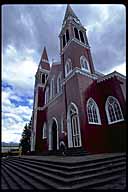
Costa Ricans are said to be "lukewarm" when it comes to religion. Although more
than 90% of the population is Roman Catholic, at least in name, almost no one
gets riled up about their faith. Sure, Holy Week (the week before Easter) is a
national holiday, but it's simply an excuse for a secular binge. The passing of
the parish priest inspires no reverential gestures. And most Costa Ricans
respond to the bell, the public voice of the church, only on special occasions,
generally when the bell peals for birth, marriage, and maybe for Easter
Morning, when the mass of men mill by the door, unpiously half in and half
out.
The country has always been remarkably secular, the link between
Christianity and the state--between God and Caesar--always weak. The Costa
Ricans' dislike for dictators has made them intolerant of priests. The feudal
peasants of other Central American nations, miserably toiling on large estates
(latifundias) or their own tiny plots, may have been poor and ignorant,
but the Church offered them one great consolation. Theirs would be the kingdom
of heaven. And in more recent times, when Catholic organizations attempted to
address pressing social problems, they strengthened the Church's bond with the
people. In Costa Rica, by contrast, the Church, from the earliest colonial
times, had little success at controlling the morals and minds of the masses.
While poor peasants can be convinced they'll become bourgeois in heaven, a
rising class wants its comforts on earth. Costa Rica's modernity and
"middle-class" achievements have made the Church superfluous.
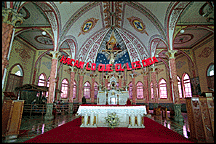 Still, every village no matter how small has a church and its own
saint's day, albeit celebrated with secular fervor. Every taxi, bus, government
office, and home has its token religious icons. The Catholic marriage ceremony
is the only church marriage granted state recognition. And Catholicism is the
offical state religion. The 1949 Constitution even provided for state
contributions to the maintenance of the Church; and the salaries of bishops are
paid by the state.
Still, every village no matter how small has a church and its own
saint's day, albeit celebrated with secular fervor. Every taxi, bus, government
office, and home has its token religious icons. The Catholic marriage ceremony
is the only church marriage granted state recognition. And Catholicism is the
offical state religion. The 1949 Constitution even provided for state
contributions to the maintenance of the Church; and the salaries of bishops are
paid by the state.
Catholicism, nonetheless, has only a tenuous hold; mass in some
rural communities may be a once-a-year affair, and resignation to God's will is
tinged with pagan fatalism. In a crisis Ticos will turn to a favorite saint,
one who they believe has special powers or "pull" with God, to demand a
miracle. And folkloric belief in witchcraft is still common (Escazú is
renowned as a center for brujos, witches who specialize in casting out
spells and resolving love problems).
Protestantism has proved even less spellbinding. The Catholic
clergy has fiercely protected its turf against Protestant missionaries (even
Billy Graham's tour in 1958 was blackballed by the local media), and the
Protestant evangelism so prevalent in other parts of Central America has yet to
make a dent in Costa Rica. A great many sects, however, have found San
José the ideal base for proselytizing forays elsewhere in the isthmus.
The nation's black population constitutes about half of Costa Rica's 40,000 or
so Protestants, though the archbishop of Canterbury would be horrified at the
extent to which "his" religion has been married with African-inspired,
voodoo-like obeah and pocomoia cult worship.
EDUCATION
The briefest sojourn in San José makes clear that Costa Ricans are a
highly literate people: the country boasts of 93% literacy in those 10 and
over, the most literate populace in Central America. Many of the country's
early father figures, including the first president, José Maria Castro,
were former teachers and shared a great concern for education. In 1869, the
country became one of the first in the world to make education both obligatory
and free, funded by the state's share of the great coffee wealth (as early as
1828, an unenforced law had made school attendance mandatory). Then, only one
in 10 Costa Ricans could read and write. By 1920, 50% of the population were
literate. By 1973, when the Ministry of Education published a landmark study,
the figure was 89%.
The study also revealed some worrying factors. Over half of all
Costa Ricans aged 15 or over--600,000--had dropped out of school by the sixth
grade, for example. Almost 1,000 schools had only one teacher, often a
partially trained aspirante (candidate teacher) lacking certification.
And the literacy figures included many "functional illiterates" counted by
their simple ability to sign their own name. The myth of "more teachers than
soldiers" and the boast of the highest literacy rate in Central America had
blinded Costa Ricans to their system's many defects.
The last 20 years have seen a significant boost to educational
standards. Since the 1970s the country has invested more than 28% of the
national budget on primary and secondary education. A nuclearization program
has worked to amalgamate one-teacher schools. And schooling through the ninth
year (age 14) is now compulsory. Nonetheless, there remains a severe shortage
of teachers with a sound knowledge of the full panoply of academic subjects,
discredited rote-learning methods are still common, remote rural schools are
often difficult to reach in the best of weather, and the Ministry of Education
is riven with political appointees who change hats with each administration. As
elsewhere in the world, well-to-do families usually send their children to
private schools.
Village libraries are about the only means for adults in rural
areas to continue education beyond sixth grade. The country, with approximately
100 libraries, has a desparate need for books and for funds to support the
hundreds of additional libraries which the country needs. Books (Spanish
preferred) can be donated to the National Library (c/o Vera Violeta
Salazar Mora, Director, Dirección Bibliotecas Públicas, Apdo.
10-008, San José; tel. 236-1828).
A new program recently instigated by the Ministerio de
Educatión accepts volunteers to teach English (Departamento de
Inglés, San José 1000). WorldTeach (Harvard Institute for
International Development, 1 Eliot St., Cambridge, MA 02138; tel. 617-495-5527,
fax 617-495-1239) also places volunteers to teach English in schools that have
requested assistance. The local school or community provides housing and a
living allowance; you pay a participation fee of $3500 that covers airfare,
health insurance, training, and field support.
Universities
Although the country lacked a university until 1940, Costa Rica now boasts four
state-funded schools of higher learning, and opportunities abound for adults to
earn the primary or secondary diplomas they failed to gain as children.
The University of Costa Rica (UCR), the largest and oldest
university, enrolls some 35,000 students, mostly on scholarships. The main
campus is in the northeastern San José community of San Pedro (UCR also
has regional centers in Alajuela, Turrialba, Puntarenas, and Cartago). The
National University in Heredia (there are regional centers in Liberia
and Perez Zeledon) offers a variety of liberal arts, sciences, and professional
studies to 13,000 students. Cartago's Technical Institute of Costa Rica
(ITCR) specializes in science and technology and seeks to train people for
agriculture, industry, and mining. And the State Correspondence
University, founded in 1978, is modeled after the United Kingdom's Open
University and has 32 regional centers offering 15 degree courses in health,
education, business administration, and the liberal arts.
In addition, there are many private institutions, including the
Autonomous University of Central America and the University for
Peace, sponsored by the United Nations and offering a master's degree in
Communications for Peace.
HEALTH
Perhaps the most impressive impact of Costa Rica's modern welfare state has
been the truly dramatic improvements in national health. Infant mortality has
plummeted from 25.6% in 1920 to only 1.5% in 1990. The annual death rate
dropped from 41 per thousand in 1894 to 18 in 1944 and just 3.9 per thousand in
1989. And the average Costa Rican today can expect to live to be a ripe 73.2
years old--longer than the average U.S.-born citizen. All this thanks to the
Social Security system which provides universal insurance benefits covering
medical services, disability, maternity, old-age pensions, and death.
Currently Costa Rica assigns about 10% of its GNP to health care.
The result? A physician for every 700 people and a hospital bed for every 275.
In fact, in some areas the health-care system isn't far behind that of the U.S.
in terms of the latest medical technology, at least in San José, where
transplant surgery is now performed. Many Americans fly in for surgery,
including dental work, here. And the Beverly Hills crowd helps keep Costa
Rica's cosmetic surgeons busy.
One key to the nation's success was the creation of the Program for
Rural Health in 1970 to ensure that basic health care would reach the furthest
backwaters. The program, aimed at the 50% of the population living in small
communities, established rural health posts attended by paramedics. The clinics
are visited regularly by doctors and nurses, and strengthened by education
programs stressing good nutrition, hygiene, and safe food preparation. Even a
few years ago malnutrition reaped young Ticos like a scythe; in the last two
decades infant mortality due to malnutrition has fallen by over 80%. In April
1992, the Social Security service initiated a new plan aimed at lowering infant
mortality to one percent. It's a constant battle, however. Health standards
slipped slightly in 1990-91 due to budget cutbacks: the tuberculosis rate
doubled in 1991, for example, and that year the nation witnessed its first
measles epidemic in many years. But then again, so did the United States.
philg@mit.edu
 The July 1989 census recorded a population of 2.92 million, more than half of
whom live in the Central Valley. Approximately 275,000 live in the capital city
of San José. Fifty-one percent of the nation's population is classed as
urban. The country's annual population growth rate is currently 2.3% and
gradually falling. As recently as the 1960s the rate was a staggering 3.8% per
annum, a figure no other country in the world could then match. The impressive
decline in recent decades has likewise been matched by few other countries.
The July 1989 census recorded a population of 2.92 million, more than half of
whom live in the Central Valley. Approximately 275,000 live in the capital city
of San José. Fifty-one percent of the nation's population is classed as
urban. The country's annual population growth rate is currently 2.3% and
gradually falling. As recently as the 1960s the rate was a staggering 3.8% per
annum, a figure no other country in the world could then match. The impressive
decline in recent decades has likewise been matched by few other countries. 



